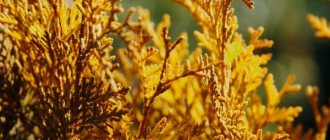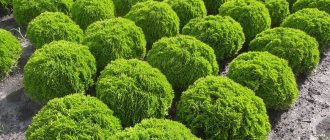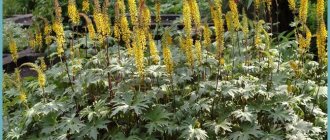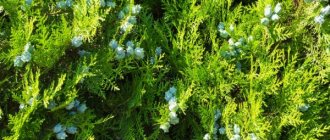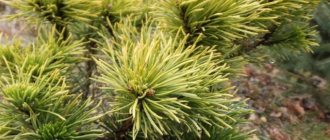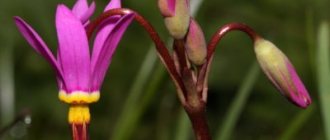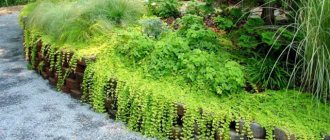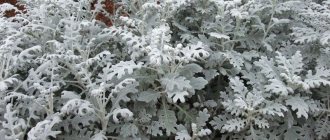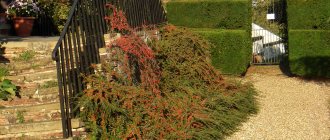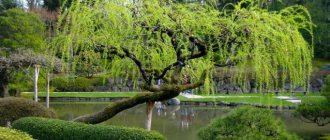Thuja Globoza: description of the variety and characteristics
Western thuja Globoza: photo of the variety
The peculiarity of the western thuja Globoza is that the change in color depends on the conditions of the planting site and growth. And also varieties of thuja. The needles of our variety can be green, golden, blue or bronze in color. The crown also comes in different shapes. It can be spherical or columnar. Pyramidal straight or inverted. The needles are soft and do not prick. The shrub is a dwarf, growing up to 1.5 m in length and, as a rule, up to 1.5 m in width.
Thuja Globosa is a slow growing plant. Annual growth is 5 cm. The needles are in the form of scales; color changes according to the seasons. In spring, the needles acquire a light green tint. It gets darker in the summer season. In the autumn season it turns brown or gray-green. The needles densely cover the shoots, which grow vertically. They intersect, thereby increasing the density of the crown.
Twice a year a haircut is carried out to give the crown a certain shape. And also in order to support the already formed apical part. Pruning the western thuja Globoza will save the crown from looseness. The thuja variety Globoza is winter tolerant. Because he is not afraid of frost. And also lives long. The shoots form small cones about 1 cm in size.
Description
Western thuja "Globoza" is a plant belonging to the category of coniferous shrubs. It began to be grown en masse in 1874. The plant is popular and loved among a large number of gardeners and landscape designers. The plant is valued for its aesthetically pleasing appearance, as well as its ease of care. That is why this variety of thuja is often used to decorate garden plots. Thuja has a spherical shape and relatively small size. So, the height of the plant does not exceed 1.5 meters. The width of the bush is approximately in the same range. In connection with such indicators, scientists classify “Globoza” as a dwarf plant. The plant is winter hardy.
Important. Inexperienced gardeners often confuse thuja "Globoza" with juniper. Be careful when purchasing plant seedlings.
An adult plant produces shoots that are quite thick and dense in structure. They grow vertically upward and can be directed in all directions. Despite the fact that thuja is a coniferous plant, its needles are soft and pleasant to the touch. They are painted in a rich green tint (sometimes you can see a slight yellow undertone). However, this coloring is typical for the plant in the warm season. In winter, the thuja acquires a brown tint. Thuja variety "Globoza", like the rest of the brethren of this plant, has cones. They are painted in beige shades.
Types of thuja
Globose western thuja Globoza: photo of the variety
- Western Thuja Globosa Aurea . The shape of the crown is in the form of an egg or a ball. The height of an adult plant reaches 1.2 m. The needles are light green in color. The spherical thuja shrub Globosa Aurea is used in group plantings. Or he lands alone. The tree is not afraid of frost. It also winters well. In spring, shading is required to prevent the needles from drying out or getting burned. Differs in tolerance to partial shade. Thuja Globoza Aurea likes to grow on nutritious loamy soil. In other soil, as a rule, good growth also occurs. There is no additional need to cut thuja. Suitable for rock gardens and rockeries.
- Western thuja Globoza Nana. The most decorative type among thujas with a ball-shaped crown. The variety is not afraid of frost. Undemanding to care and climatic conditions. It also has dense needles. An adult plant reaches a height of 0.3-0.5 m, a width of 0.8 m. The needles are colored green or golden-yellow. The thuja variety Globoza Nana likes to grow in acidic soil. This plant is an acedophilus. These thujas are used to create hedges, rockeries, and rock gardens. Plants are also grown in containers. There is no additional need for cutting.
Globose thuja Globoza: photo of the variety
- Western thuja Globoza Gold . Has strong frost resistance. Can grow at temperatures down to -34 degrees. Crown in the shape of a ball or circle. It is required to plant in nutritious, moist soil. This is a slow growing shrub. The needles of old plants loosen and their shape is lost. Thuja Globoza Gold grows up to 1 meter. Its color is golden-green or yellow. The variety does not like dry periods. It is whimsical to moisture, prefers spraying. During the winter, the crown is tied up to prevent it from falling apart from the snow cover. Also, the western thuja variety Globoza Gold is used in large compositions.
Before choosing a thuja variety, carefully study the information about each variety.
Care
Caring for the globular western thuja after planting is not very difficult. The plant is very unpretentious.
Watering
Young plants are watered once every 7 days; in dry and hot weather, the number of waterings is increased to 2 times a week. One bush uses 10 liters (a bucket) of water.
Also suitable for thuja is the sprinkling method, which uses a special sprinkler.
Feeding
Young specimens are fed only from the second year of life. Complex mineral fertilizers are used in the spring, because it is at this time of year that the shrub enters the active growing season. Recommended dosage is 50-60 g per 1 square meter. meter.
Thuja responds well to fertilizing with organic substances. Compost and humus (cow, horse, leaf) are used as such. Organic matter is laid to a depth of 10 cm.
Mulching and loosening the soil
Loosening increases the supply of oxygen to the roots and is carried out immediately after watering. Loosen the soil around the young bushes very carefully, because the roots of the thuja are located close to the surface.
Mulching is also important. It allows you to eliminate excess moisture evaporation. Peat, compost or shavings are used as mulch (lay at least 7 cm thick).
Haircut and trimming
The Globoza variety responds well to pruning. No more than a third of the length of the branches is removed. The procedure is recommended to be carried out in the spring:
- if the plant is single, do a sanitary pruning: remove diseased, old and dry parts. It is also possible to thin out dense and overgrown branches.
- plants in the hedge are given formative pruning. It can be done in late spring and early summer.
The ball-shaped crown of the thuja provides enormous scope for decorative formation. Skillful hands can create real masterpieces of landscape design from it.
Preparing for winter
Winter is very difficult for young bushes, so in late autumn you should take care of their shelter. Spruce branches are suitable for this purpose. It is also used in the fall and instead of mulch (this will repel field mice from the plants).
You can also make a shelter with fallen leaves or special agricultural materials. Additionally, young bushes are wrapped in film when the air temperature reaches -5ºC and below.
Adult spherical thujas are winter-hardy and can withstand even severe frosts. It is not necessary to cover them, but you should tie the branches with twine so that they do not break under the blanket of snow.
How to use Thuja Globoza in landscape design
Globose thuja Globoza in landscape design: photo of the variety
Landscape designers value thuja for its original crown and coloring. And also the density of the needles. Thanks to these features, plants are used to create hedges. When decorating rock gardens and rockeries. The western thuja variety Globoza is a component of large decors and mixborders. With the help of shrubs, terraces, front entrances and loggias are landscaped. If you trim the thuja in a timely and regular manner, this will help give it a certain shape for the desired decoration. Thuja is combined with perennial plants that bloom. They are also used to frame lawns.
Popular varieties
Among the most popular and in demand varieties of spherical thuja for garden plots are the following types:
Teddy
This is a dwarf variety that grows very slowly. During the year, the shoots lengthen by only 2-3 cm. An adult plant is 40-50 cm in height and 30 cm in girth. Teddy can be grown in a pot, however, in this case it is important to provide it with regular and moderate watering. The crown of the bush is dense, dense, with needle-shaped foliage, but soft to the touch. Doesn't need any formation.
Related article:
What to do if the thuja turns red after winter
Rekuva Nana
Thuja Rekuva Nana has a spherical shape only when young. Subsequently, it stretches into a tall, lush cone with regular outlines. The crown lends itself well to adjustment, so it can be given the required shape. This variety can be used to create a "living wall" or as a single standing tree ("solitaire").
Brabant
A spectacular fast-growing thuja, which is most often used to create hedges. Like Rekuva Nana, Brabant has a spherical shape only in its “youth”. Over time, the plant becomes a lush cone-shaped tree that can grow up to 6-8 m. The annual growth of Brabant is 50-70 cm, so with its help you can very quickly get a thick green wall.
Related article:
How to propagate and root boxwood
Wagnery
Medium-sized thuja with a broadly ovoid crown. In “youth” it has a round shape, and in adulthood it turns into a wide cone 3.5 m high and 2.5 m in girth. Used for single and group plantings near residential buildings, as well as when creating garden compositions. Wagner needles are grayish-green and glossy. It is better to plant the plant in well-lit areas. It will grow in the shade, but in this case the crown develops worse and loses its attractiveness.
Globoza
An attractive shrub with numerous branched shoots. By the age of 10, it grows to 1.5-2 m in height with the same diameter. Annual growth is 8 -15 cm, depending on growing conditions. The crown is dense, compact, and takes on a ball shape by the age of 5-6 years. Does not require corrective pruning. The needles are thick, fluffy, and change color depending on the time of year. In summer and autumn it is dark green, by winter it acquires a copper tint, and in spring young growths of a light emerald color appear.
Related article:
We save thuja from yellowing with fertilizing
Mr Bowling Ball
The soft greenery of the bush has a rich green color. The color remains in winter, but a light bronze coating appears on the tips of the branches. Mr. Bowling Ball forms into an almost perfect ball that requires no additional trimming. And the openwork arrangement of the needles gives the bush lightness and airiness.
The annual growth of the thuja is only 5-6 cm. In adulthood, its height is 60-70 cm, and its diameter can increase up to 1 m. Mr. Bowling Ball reaches its maximum size by the age of 10 and retains these parameters until the end of his life.
Miriam
Miniature coniferous shrub. It was obtained as a result of a mutation of the thuja Danica relatively recently. Grows up to 60 cm in girth. It grows very slowly: by the age of 5, seedlings reach only 25 cm in height. The crown is dense, regular spherical in shape. The needles are scaly, green-golden in color. In winter it turns dark orange, and in spring it turns yellow-green again.
Related article:
How to trim thuja correctly
Danica
A popular slow-growing variety with a delightful emerald round crown that does not require pruning. Ideal for implementing any garden compositions, as well as for growing in pots. It can easily be placed even on a small area or balcony. The crown is thick, fluffy, with densely spaced shoots.
Danica grows slowly, increasing by about 5 cm per year. It reaches its maximum size by 10-15 years, while the height of the bush is 50-60 cm with the same diameter. The needles are short, openwork, scale-like, with a glossy coating on the plates. In winter it becomes bronze. It is better to plant the plant in a sunny area, since in the shade the foliage becomes pale and loose.
Woodwardy
Dwarf thuja with light green dense needles without gaps. The crown is broadly ovoid and develops well in sunny areas and light partial shade. The foliage and branches are very soft. The shrub grows slowly, increasing by no more than 5 cm per year. On average, the size of an adult plant (at 10 years of age) is 40 cm in height and 50 in width. However, it continues to develop further, and at 30-35 years old it can reach 1 m.
Related article:
Ideal conifers for a summer cottage: 6 best varieties of decorative spruce
Reingold
Decorative bush with bright yellow needles. At a young age, the crown has a spherical outline, and over time it becomes broadly conical. The height of the bush is 2-3 m, and the width is 1-1.5 m. The foliage is scaly and needle-shaped, changing its color depending on the season. It turns golden yellow in late spring and summer, turns bronze in winter, and produces orange-pink new growths in spring.
Golden Globe
A highly decorative species of coniferous shrub, which has been cultivated since 1754. Widely distributed in the Northern Hemisphere on all continents. Thuja Golden Globe is actively used in landscape design as a “border” plant, or for zoning an area, or to implement various garden compositions. The bush has a bright appearance, is unpretentious in care, and adapts well to various climatic conditions. Its crown has a golden-green color and, with proper care, does not lose its attractiveness over time.
Related article:
How to trim thuja correctly
Golden Globe is a dwarf thuja. Its annual growth is 5-8 cm. And the bush grows above 1 m only after 15-20 years.
Teeny Tim
A miniature thuja that is perfect for small areas, as well as for creating rockeries, borders, and container growing. It is distinguished by a very slow growth rate (only 2-3 cm per year), a dense crown with thin, highly branched shoots, and a highly decorative appearance. Nurseries usually sell 4-5-year-old seedlings, the height of which is 15-20 cm. Only by the age of 10 will the plant form a crown 30 cm high and 40 cm in diameter.
Emerald
Smaragd is often called “thuja on a leg”, since the plant can form a trunk over time. The result is a decorative tree with a very unusual appearance. Smaragd belongs to the cone-shaped, medium-sized varieties and can grow up to 5-6 m in height and 1.2 m in width. However, it will only reach this size by the age of 20. The variety is unpretentious in care, shade-tolerant, frost-resistant, tolerates drought and excessive moisture.
Related article:
6 varieties of thuja that are ideal for decorating a cottage or country plot
Methods of propagation of thuja Globoza
Globose thuja Globoza: photo of the variety
Reproduction of thuja Globoza occurs in 2 ways.
- Propagation of thuja Globoza by seeds . There is no guarantee that the varietal characteristics of the tree will be preserved. Seed collection is carried out in the second or third autumn month. As they ripen, the cones open. Stratification lasts 2-3 months. Then the grains are sown. Thuja seeds are not stored. The next year after sowing, the seedlings are transplanted into the soil. Aged for 2-3 years. Next there is a transplant to the site.
- Propagation of thuja Globoza by cuttings . Fast and reliable. It is used in the spring and autumn seasons. In order for the petioles to root successfully, they must have a “heel”. Next, treatment is carried out with a stimulator for root growth. As well as moving into the soil mixture. In the fall, they are rooted in a zip bag. Seedlings are planted in the ground when new branches appear on them. This method will allow you to grow a large number of new shrubs.
General characteristics
Thuja round (also spherical or spherical) is a coniferous shrub of the Cypress family. It is called “round” due to the shape of its thick, lush crown, which naturally forms a ball or ellipsoid during the growth process. The crown does not even need to be specially formed. But if desired, it can be easily trimmed and given any desired shape. The size of the shrubs varies depending on the variety. Their height can range from 40 cm to 8 m, and some specimens exceed 5 m in diameter. In addition, the bushes differ in the color of their needle-like leaves and can be emerald, golden, brown or orange.
Related article:
Varieties of juniper with photos
Thuja spherical, which is most often chosen for growing in personal plots, belongs to the Western species. It is this species of Cypress that stands out for its excellent seedling survival rates, is frost-resistant, shade-tolerant and tolerates drought well. In addition, a large number of varieties of Western spherical thuja will allow you to choose a shrub that will fit into the dimensions of even the most compact plot. Other types of thuja include Korean, folded (giant), Japanese and Sichuan. Their garden forms are also cultivated as decorative and have a number of their own advantages, but are used more often in parks and other large areas.
Thuja globulus is a long-liver. Its lifespan is 50-150 years, depending on the variety and growing conditions. The needles of the shrubs are scale-like, tightly pressed to the shoot. It functions for 2-3 years, and then falls off along with small branches. Young needles are very soft, but over time they become hard.
Cypress trees are not only aesthetically important, but also beneficial for health. They release essential oils and other substances into the air that have a beneficial effect on the human body.
Thuja Globoza: planting a variety
Western thuja Globoza: photo of the variety
Before planting thuja Globoza, study the information about the stages and features of planting. Choose your planting material carefully. Buy plants from special nurseries or grow them yourself. The optimal choice is a bush with a closed root system. The survival and adaptation of these bushes will occur faster and more efficiently. If you find damage or signs of disease in plants, set them aside.
When is the best time to plant plants?
Thuja Globoza in landscape design: photo of the variety
The active growth of thuja Globoza begins in May. For this reason, replant plants in the spring. After that, when repeated frosts definitely no longer threaten. Or in the autumn season - in early September.
How to choose a site for planting thuja Globoza and prepare the soil
The area for planting western thuja Globoza should be well lit. Or be in partial shade. But then there will be a slight loss of decorativeness by the needles. And also the crown will become loose. Soil moisture. Do not plant bushes in a place where groundwater flows close to the surface. If they lie more than 1.5 cm to the surface, then make a small soil mound.
The soil is prepared slightly acidic, moderately fertile. And also moderately moisturized. If the soil is loamy, then there is no need to prepare it further. For other types of soil, mixtures are selected. The planting site is cleared of weeds, dug up and loosened.
Work progress
- First, a hole for planting is prepared, measuring 50x60 cm in the shape of a cube. The depth of the hole should be greater than the size of the earthen clod.
- If you are planting a hedge, then the interval between thujas should be 60-70 cm. When creating a composition, the interval is made according to the plan.
- The drainage system is laid out in the form of a 15-20 cm layer. Drainage composition: fine gravel, expanded clay, broken brick.
- A layer of fertile soil mixture consisting of sand, turf and peat is poured. You need to pour the mixture into a mound.
- The seedlings in the container are watered in advance to remove them without damaging the root system.
- The thuja with a lump of earth is placed in a mound and covered with soil. The soil is slightly compacted.
- Next, the root circle is watered and mulched.
- When planting plants, make sure that they are positioned vertically. And the root collar rose 2 cm above the soil surface.
Photo of thuja occidentalis
Read here How to drain an area with your own hands: how to make a drainage system, a device for draining areas (130 photos + video description)
Did you like the article?
0
Thuja Globoza: rules of cultivation and care
Globose thuja Globoza: photo of the variety
Caring for Thuja Globoza is simple. Agrotechnical techniques: water, feed, loosen and mulch. Trim and shape the crown. And also prepare for wintering. The variety is immune to disease. If you care for it properly, the thuja will grow healthy.
How and when to water
The western thuja variety Globoza does not tolerate excessive dryness and moisture in the soil. Therefore, carefully monitor the moisture of the soil. Especially if the shrub grows in a tub or container. Watering is carried out 1 time/7 days. If the time is dry, then you can add more water. An additional procedure is sprinkling the needles.
Thuja Globoza: feeding
The application of fertilizers depends on the fertility of the soil. The first time they are fed 3 years after planting. But here is a nuance - the thuja must be planted in fertile soil. You can feed 2 times/period. Thuya likes organic fertilizers. Therefore, compost fertilizer or humus is added to the soil 10 cm deep. Before this, this soil layer must be removed. Next, a layer of crushed pine bark is placed behind the top dressing. The following can be used as additional feed: horse or cow manure. As well as ready-made mineral complexes. But add minerals with caution so as not to overdo it. And do not reduce the acidity level of the soil. A good mixture is Kemira-Universal. Dosage – 50 g/square.
Thuja Globoza pruning procedure
The western thuja variety Globoza has good tolerance to haircuts and pruning. This promotes crown formation. Giving the shrub a certain look. And also maintaining the density of the needles. The bush grows slowly. Thuja Globoza is pruned in the spring after the buds have opened. Broken or damaged branches are removed. To form a bush, the shoots are cut to one third of their length. Once every 3 years, rejuvenating pruning is carried out, during which the shoots are shortened by half their length.
Thuja Globoza: preparing for the winter season
Before the cold weather sets in, the bush hills up. The shoots are neatly tied. They are also covered with agricultural materials. In spring, the cover is not removed immediately. It is necessary to gradually accustom the branches to the sun. Therefore, the shelter is removed for a certain period of time.
Arborvitae in landscape design: features and advantages
Before you go shopping, we suggest you understand the features and main advantages. First of all, we note that thujas are evergreen plants that can thrive in a temperate climate without excessive heat or cold. Therefore, they can be grown almost anywhere. However, there are individual care features depending on the chosen variety.
In addition, we note that thuja can be of completely different sizes. For example, shrubs are rarely more than half a meter high. But there are also larger options that grow up to two meters in height and visually resemble trees. Therefore, all these features should be taken into account when choosing. After all, thujas can complement certain decorative elements or be planted separately.
Harmful insects and diseases
Although the Western thuja variety Globoza is immune to disease. But he may suffer due to disrupted care. If harmful insects (false scale insects) are noticed on the bushes, then treat them with insecticides. Preparations: “Aktellik”, “Aktara”, “Fufanon”. If the branches dry out, treat them with the following preparations: “Hom”, “Abiga-Pik”, “Topaz”.
Conditions for keeping thuja
Western thuja is not picky about care and does not require difficult conditions. Coniferous trees feel great even in a big city.
For an evergreen beauty, loamy-moist and fertile soil is suitable, but thuja feels good in any conditions. It is recommended to plant an evergreen plant in places hidden from strong winds and drafts.
In winter, the branches of the western thuja need to be shaken off from snow. For fragile varieties, it is recommended to protect the entire bush and cover the branches with burlap for the winter.
When caring for western thuja, you should remember that this variety of evergreen plants does not like waterlogging. Watering should be moderate, without drought and excess moisture.
Thuja does not need additional feeding, but once a year it is recommended to give the plant fertilizer. You should not remove fallen needles; they serve as food and fertilizer for western thuja.
Western Thuja Globoza: reviews from gardeners
Globose thuja Globoza: photo of the variety
Marina Igorevna, Belgorod region: “I love thuja in the shape of a ball. My territory is small. For this reason, you cannot plant many coniferous plants. The spherical thuja Globoza is undemanding to care. But at the same time decorative. I cultivate it with pleasure. I advise beginners to carefully monitor watering. And also lighting to avoid injury to your thuja Globoza.”
Alevtina Semenovna, Voronezh region: “We made a hedge from the western thuja Globoza. The needles are dense and easy to shape. You can cut and trim 2 times a year. You need to feed a little. It's better to keep an eye on watering. If the soil is fertile, then you don’t need to apply fertilizer. I recommend spraying or watering the plants better. In shaded areas, as a rule, Thuja Globoza may lose its beauty. In direct sunlight, you need to moisturize regularly.”
Diseases and treatments
Thuja Globoza is resistant to many diseases. But if the rules of care are not followed, it can become infected with late blight and the appearance of false scale insects. You can get rid of the disease by treating the plant with insecticides such as Fufanon, Aktara, Aktellik.
If the branches begin to dry, the conifers are sprayed with fungicides: Topaz, Hom or Abiga-Pik.
Why do needles turn yellow and fall off?
Yellowing of needles can occur for natural reasons and as a result of diseases.
Main factors:
- Darkening of needles at the end of the growing season. As a rule, this occurs in late autumn. This is a normal phenomenon, in this way the plant prepares for winter and cold weather.
- Improper care of young seedlings. When planting, the tree is not shaded from direct sunlight and is not watered in a timely manner.
Common diseases that lead to yellowing of needles:
- Incorrectly planted seedling. The root collar is buried, leading to rotting of the root system.
- Root burns. Excess fertilizer and lack of oxygen can cause burns. The tree begins to turn yellow, turn brown and eventually dies.
- Damping off of the plant. Occurs due to planting close to each other when growing hedges.
Prevention
In the first place is proper planting and care:
- The soil around the plant should be loose and free of weeds, since weeds spread insect pests.
- Thuja grows well in soil with an acidity of 6 pH.
- Timely watering and introduction of fertilizers.
In the fall, the soil is not fertilized; fertilizing is applied in the spring, during active growth.
Proper preparation for winter:
- the trunk circle is covered with foliage;
- the crown is covered with burlap or other breathable material;
- To avoid breakage of branches, it is necessary to periodically remove snow from the plant.
You can find out why thuja needles turn yellow from the video:
Landing
In order for the thuja to attract everyone's attention and become a real treasure of the garden, you should approach both the determination of the place of residence and the choice of seedling with responsibility.
Selection of seedlings
The appearance and health of the future tree depends on the selected seedling. It is better to buy it in specialized nurseries. In the market you may come across low-quality goods or scammers.
Preference should be given to specimens in containers. An open root system weakens the immune system and causes long adaptation to a new place.
The seedling must be externally healthy and strong without noticeable damage or dry needles. The optimal age of seeding material is 7-9 years; younger representatives of cypress trees may not take root.
The cost of a crop fluctuates noticeably and directly depends on the size of the plant. The price for specimens up to 50 cm does not exceed 1,700 rubles, large ones cost several times more - from 7,000.
Preparing the site
When choosing the location of a spherical thuja, its requirements for climatic conditions should be taken into account. It is better to plant in a place with a small number of tall crops, because it requires space and openness.
The sun can burn the needles
You should not plant shrubs in areas exposed to direct sunlight, which can cause severe damage to the needles. The best option is partial shade.
Under conditions of strong shading, the green mass fades, and the tree itself noticeably slows down its growth. Sharp winds are also destructive to the flora.
It is better to prepare the seeding hole in advance, about 2 weeks in advance. The soil where the plant is supposed to be located is dug up and loosened. The average depth is 60-80 cm. If planting in groups, then you need to take into account the rapid growth of the root system of the crop horizontally and place the holes at a distance of at least 1 m from each other.
Sometimes the soil mixture is prepared independently. To do this, mix sand, peat and turf soil in a ratio of 1:1:2. If the fertile layer is poor, mineral fertilizers are added in moderate quantities.
Landing technology
When planting, you must adhere to the following sequence:
- Water the seedling abundantly directly in the container; only after this is it possible to remove the plant from the container.
- If clay predominates in the substrate or if groundwater is close, form a drainage layer 20 cm thick from gravel, crushed brick, and crushed stone.
- Place the seedling in the center of the hole so that the neck is on the border with the surface. The remaining cavities are filled with prepared soil and watered.
Reproduction
There are 2 main methods of propagation of western thuja: seeds and cuttings. The first is a labor-intensive process, takes at least 3 years and is extremely rarely successful - the shrub does not retain its characteristic shape, which transforms into a columnar shape.
In this case, the seed material is collected in the spring, kept in growth stimulants and stratified. After a couple of months, they are planted in the ground, creating greenhouse conditions. In the first year, the height of the seedlings does not exceed 7 cm; they reach 50 cm only after several seasons.
Ephedra is propagated by cuttings at the end of July or August. To do this, woody branches 40 cm long are separated from the mother tree (young shoots of the current year, not exceeding 20 cm, are also suitable) so that the “heel” remains on them. The lower part is cleaned and kept in a root former for 24 hours.
Then they are embedded in the substrate to a depth of 2-3 cm, treated with potassium permanganate and covered. Mandatory conditions for development are high humidity in the greenhouse and systematic ventilation. Such “blanks” are watered by sprinkling the soil.
How to plant?
The successful development of a tree largely depends on whether it was planted correctly and whether all necessary measures were taken during planting.
- The most optimal type of soil for thuja of the Globoza genus is considered to be loam. However, the plant can actively develop on other soil. In order for the thuja to take root well, additional components such as compost, sand, peat, turf and mineral complexes should be added to the soil.
- In order to plant a plant, you need to make a hole in the soil. Its size directly depends on the size of the root of a particular seedling. Moreover, when planting, the recess should be made slightly larger than the size of the root system (it is believed that such a reserve should be 25 centimeters in depth and 30 centimeters around the perimeter).
- After you have placed the seedling in the ground, it is necessary to water it abundantly. The soil around the trunk must be mulched with mowed grass (however, any other materials of natural origin can be used).
- In addition, the mulching process should be repeated before the onset of cold weather. This time, spruce branches can serve as mulch. This material will protect the plant from rodent pests, and the seedlings, in turn, will be able to safely survive the winter cold.
- Thuja "Globoza" can be grown in almost any climatic conditions. The plant is quite persistent and hardy. It tolerates both frost and scorching sun well. However, in the spring, you should definitely take care of removing bush branches that have already deteriorated or dried out.
Read also: How to clean a Thermex water heater video
